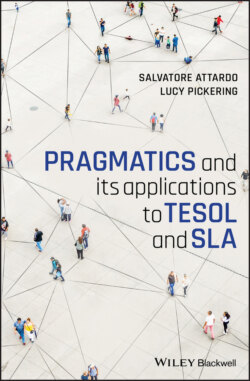Читать книгу Pragmatics and its Applications to TESOL and SLA - Salvatore Attardo - Страница 13
Extensional Semantics
ОглавлениеMost or all of philosophical semantics takes place within the extensional framework. This does not mean that philosophers do not see the difference between sense and referent. In fact, we owe the first clear statement of the difference to Frege, one of the founders of philosophical semantics. However, generally speaking, philosophers are interested in problems of meaning only as a tool to get at truth. The idea is pretty simple: any sentence consists of, at least, a proposition. So, Mary loves tea, The sky is blue, and Socrates is mortal are all sentences, and each of them can be expressed as a proposition. Traditionally this proposition is indicated as “p” (short for “proposition”). Propositions can be true or false, unlike words. A proposition is true if it describes a true state of affairs, and false if it doesn’t. So if Attardo says I am a bachelor p (= Attardo is a bachelor) is false, as Attardo is in fact married to Pickering. Many linguists have taken the position that “semantics is limited to the statement of truth conditions” (Levinson, 1983, p. 12), thus limiting the scope of semantics to extensional, truth-functional semantics. The name truth-functional comes from the fact that the truth-value of a compound sentence is a function of the truth-value of its constituents: so if Mary loves John is true and Mary loves Bob is true, the overall sentence Mary loves John and (Mary) loves Bob is also true. If either component sentence is false, the overall sentence is also false. This is an important principle, called compositionality, which states roughly that the meaning of a sentence is the sum of the meaning of its components.
Since Aristotle, logic has been preoccupied with determining, given the truth or falsehood of a proposition, how to determine the truth of other propositions that are related to it. The syllogism, which you may have studied in a critical thinking class or in an introduction to philosophy, is precisely one such technique. If one says Socrates is human (= p) and All humans are mortal (= q), it follows from the truth of p and q that Socrates is mortal.
Syllogisms are not the only conclusions that logicians draw. Take the word “bachelor”: If one is a bachelor it follows necessarily (logically) that one is not married. It would be a contradiction to say Bob is a bachelor but he’s married. So, when we have a proposition “x is not married” (q) that follows logically from another (x is a bachelor = p), then we call q a logical inference of p. Note that in common parlance, we use sometimes “infer” differently, as in the police inferred that the crime happened at 5:00 am. A logical inference is a technical term.3
Another related technical term is presupposition. Let’s take again our sentence, Bob is a bachelor. As we just saw it follows logically (it is an inference) that Bob is not married. Now consider the negation of Bob is a bachelor, namely Bob is not a bachelor. If we consider these two sentences together, it no longer follows that Bob is not married, since if he is not a bachelor he must be married. In other words, the inferences are neutralized by the negation of the proposition. So, does anything follow from both Bob is a bachelor and Bob is not a bachelor? Yes. First, that there is someone called Bob that the speaker and the hearer both know. Second, that this Bob person could potentially be either married or not. If it turns out that Bob is in fact a two-year old baby, both Bob is a bachelor and Bob is not a bachelor would be odd and inappropriate (although it could be said jokingly). So, presuppositions are inferences that resist negation: if you can draw an inference from a proposition and its negation, those inferences are presuppositions.
The reason inferences and presuppositions are important is that they follow from a given proposition, albeit differently, and thus are part of the overall meaning of an utterance. This is crucial for the definition of pragmatics. Imagine if someone asks Is Bob married? and the answer is Bob is a bachelor. On the surface, the answer does not answer the question, which is a yes/no question, so technically only a choice of “yes” or “no” is a proper answer. However, when you consider the inferences, that is, if Bob is a bachelor, then it follows that Bob is not married, by logical inference, the answer is in fact quite satisfactory. Recapping: we have the meaning of a sentence, in the form of a proposition, and then other meanings that can be derived from this proposition. That’s fairly clear, but it’s not the end of the story. There is more to pragmatics than propositions, inferences, and presuppositions.
